Summer in the Philippines has ended and we are now bracing for monsoons and typhoons. But before you keep your backpacks, cancel all your local out-of-town trips or travel outside the country, you might want to try the other local destinations that are best experienced during rainy season or go to other places in the Philippines with lesser or absence of rain when it is pouring hard on where you are.
But when exactly is the rainy season? It actually depends on your geographical location.
Rainy Season Activities
Believe me, there are activities best enjoyed during rainy season aside from malling. Among them is white water rafting, one of my favorite adrenaline boosters. In fact most white water rafting organizers in the Philippines prefer rainy season since the water in the river is high and the rapids are wilder. For adventure lovers (*ehem, like me*), you will appreciate the rapids more during this time because on summer or dry season, most rivers become unraftable thus making it impossible for this type of sport although river kayaking is still doable. The popular white water rafting sites in the Philippines are in Kalinga, Cagayan de Oro and Davao.
Lakwatsero in three popular white water rafting sites in the country:
|
|
Seasons
While the Philippines has two seasons – the wet and dry, the entire archipelago is still subdivided into four climatic types due to differences in geography and distances between the islands. So it is possible that while it is raining hard in Boracay you can still get a tan in Caramoan or Siargao.
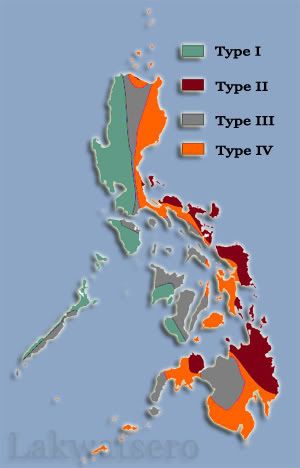
Type I: These areas have two pronounced seasons. Dry from November to April, and wet the rest of the year. Areas categorized under this type are in the western Philippines, which includes the western Palawan, Occidental Mindoro, Bataan, Zambales, Pangasinan, Cavite, Laguna and Metro Manila.
Type II: These areas have no dry season, with a very pronounced wet season from November to January. Areas under this type are mostly located in the east sides of Bicol peninsula, Visayas and Mindanao. Camarines Norte, Catanduanes, Albay, Sorsogon, Eastern Samar and Surigao are among the provinces under Type II.
Type III: These are areas with unpredictable seasons, but experts observed a relatively dry season from November to April and wet during the rest of the year. Kalinga, Apayao, Oriental Mindoro, Romblon, Masbate, Aklan (Boracay) and Antique are under this type.
Type IV: Areas under this type have evenly distributed rainfall throughout the year. Bohol, Leyte, Western Samar, Quezon Province, Aurora, Batanes, and the Pacific side of Cagayan and Isabela fall under this type.
Basis: http://commons.wikimedia.org/wiki/Image:Philippine_climate_map.png
Typhoons
If there’s one to watch out for and must call off your planned vacation, then no other else but typhoon. The Philippines is visited by an average of 20 typhoons a year. Typhoon season starts as early as May and usually lasts up to December. Most devastating and super typhoons occur from October to December.
Due also to geographical differences, not all areas in the Philippines are directly hit by typhoons. In fact the southern part of the Archipelago (Mindanao) is nearly free from cyclones, as storms are rare in the area and account only for 5 percent of the storms that cross the Archipelago. The southern islands in the Visayan Archipelago (Panay, Negros, Bohol, Guimaras and Cebu) are also rarely direct hits of cyclones. Areas that are frequently visited by typhoons include those in the Eastern Visayas, and the entire Luzon landmass, specially in the Bicol peninsula, Catanduanes, Polilio Islands, Eastern Luzon provinces of Aurora, Quezon, Isabela, Cagayan, and Batanes.
Foro ther things to do in the country this season, check out my Ten Things to Do in the Philippines This Rainy Season.


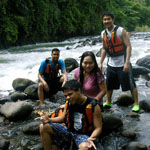
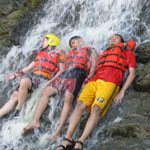

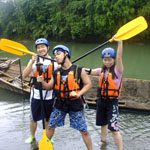
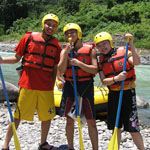
went to boracay during end of habagat season if fun, cool weather not like during summer, but one things for sure you need to have a waterproof/ water resistance bag to make sure that all your things wont get wet by the rain. I was able to buy a bag at trpologie that I used during my trip to boracay last year
This might sound odd, but I actually made my first trip to Boracay in the midst of the rainy season… when there were floods in he streets of Manila and there was a typhoon brewing over or skies!
And dare I say, I enjoyed it thoroughly! We had a room just next ot white beach, whih looks as beautiful (and less hot and balmy!) durign the rains as during sunny days. There were periods of sun, shine and cool rains, which made the weather better and walks ont h beach nicer. The beach was STILL filled with peple (far lesser than ormal in Boracay, but far more than one would see in, say, Malapascua)
You can read more about it here – http://expattraveller.blogspot.com/2012/08/boracay-been-there-done-that.html
So my advice – Boracay is a fantastic palce to visit durign teh rains. Oh yes – we danced at all the discos right upto 2 am!
Cagayan will never be typhoon free
wow! i wasnt even aware that the Philippines has 4 climatic types of season. but with climate change and all, does the description still apply nowadays?
climate change….what a tool…brainwashed fool…
Hello! Would you recommend going to Bohol during mid to late August? A friend is visiting from abroad and really wants to hit the beach. Since Boracay is out of the question because of the weather, I thought Bohol might be safer. Do you have other beach suggestions for August? Thanks!
How about sep in bohol? Is it still rainy season?
which has the strongest rapids among the three?
[…] Travelling in the Philippines during Rainy Season? […]
huwaw. grabi ansarap. inggit to the max. haha
for whitewater rafting and other adventure trips, please contact russell at 0920.952.5285 or email at [email protected]
Hello Blueu!
Adventure tayo sa Paluan, Occidental Mindoro! hehe 🙂
kakaibang place… 🙂 see mangyans din :0 Hehe!
Very informative post. Thanks for this one! 🙂
kahit pa nung summer, palaging umuulan dito. hehe.
nga po pala, nakanote na yung ililibre mo ko magwater rafting sa davao. 🙂
Impressive info :p did you draw that map yourself? heheh